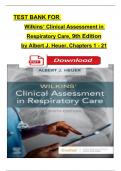Exam (elaborations)
Test Bank For Wilkins’ Clinical Assessment in Respiratory Care, 9th Edition by Albert J. Heuer, Complete Chapters 1 - 21, Updated Newest Version
- Course
- Institution
- Book
TEST BANK For Wilkins’ Clinical Assessment in Respiratory Care, 9th Edition by Albert J. Heuer, Verified Chapters 1 - 21, Complete Newest Version TEST BANK For Wilkins’ Clinical Assessment in Respiratory Care, 9th Edition pdf TEST BANK For Wilkins’ Clinical Assessment in Respiratory Care, 9th...
[Show more]



